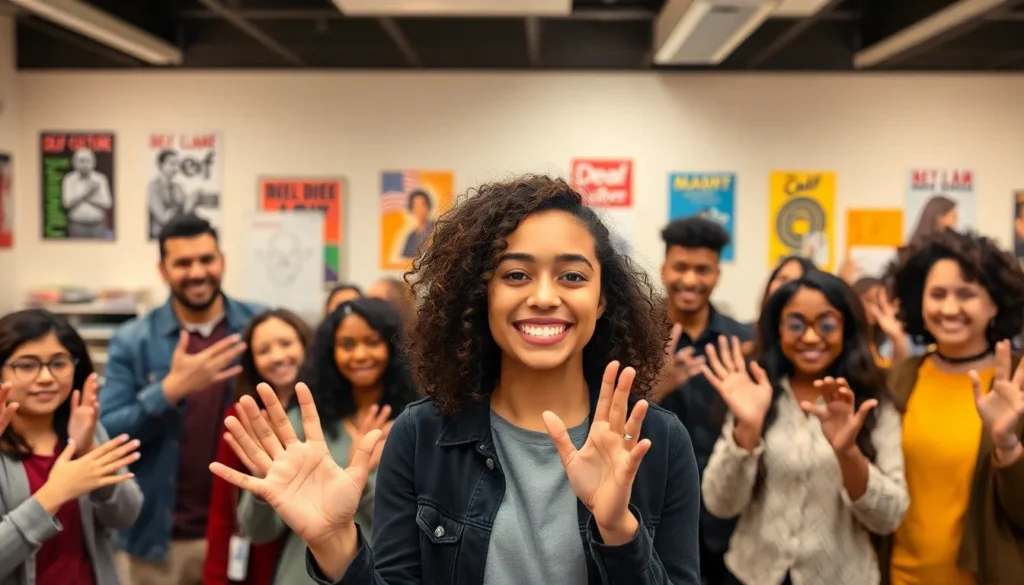Table of Contents
ToggleImagine walking into a room full of people, and instead of shouting over the noise, you start signing. Suddenly, you’re the life of the party, and everyone’s intrigued. Learning sign language isn’t just a skill; it’s an invitation to a whole new world of communication. Whether you want to connect with the Deaf community or just impress your friends, diving into sign language can be both fun and rewarding.
Understanding Sign Language
Sign language serves as a visual means of communication for people, particularly within the Deaf community. It includes gestures, facial expressions, and body movements to convey thoughts, emotions, and concepts.
What Is Sign Language?
Sign language represents a complete language system, featuring its own grammar and syntax. This language allows individuals to express ideas and feelings effectively without spoken words. Different regions may use distinct sign languages, with American Sign Language (ASL) being widely recognized in the United States.
Different Types of Sign Languages
Sign languages vary significantly across countries and cultures. Examples include British Sign Language (BSL) and French Sign Language (LSF), each with unique signs and grammatical structures. These languages reflect the cultural contexts from which they emerge. Learning different sign languages expands the ability to communicate with diverse communities around the world.
Benefits of Learning Sign Language

Learning sign language offers numerous advantages. It enhances communication abilities while bridging gaps between people.
Enhancing Communication Skills
Acquiring sign language boosts overall communication skills. Gaining proficiency in signs allows individuals to convey messages visually, promoting clarity and understanding in conversations. Expressing emotions becomes easier through gestures and facial expressions, making interactions more engaging. Developing this skill also fosters patience and attentiveness, essential qualities for effective communication. Encouraging family members and friends to learn together can create a shared experience that strengthens relationships. Building connections with those who are Deaf or hard of hearing provides opportunities for meaningful conversations, creating an inclusive environment.
Cultural Awareness and Inclusivity
Learning sign language nurtures cultural awareness. Engaging with the Deaf community deepens understanding of their unique culture and experiences. Responding to different sign languages, such as ASL, BSL, and LSF, highlights the diversity within communication methods. Appreciating this diversity promotes inclusivity, encouraging interactions with a broader range of individuals. Participating in Deaf events or social gatherings creates connections and enriches personal experiences. Recognizing the importance of sign language fosters a sense of belonging among diverse communities, cultivating respect and empathy for people from all walks of life.
Steps to Start Learning Sign Language
Starting the journey of learning sign language involves a few clear steps. Following these steps ensures effective communication within the Deaf community.
Finding the Right Resources
Locating quality materials for learning sign language makes a difference. Books and instructional videos offer foundational knowledge. Online platforms, such as websites and apps, also provide interactive learning experiences. Engaging with multimedia resources strengthens understanding. Checking out community centers or libraries can uncover additional local resources. Connecting with trusted organizations ensures reliable information is at hand.
Enrolling in Classes or Online Courses
Choosing formal education options enhances learning effectiveness. Local community colleges often offer sign language courses. Many universities provide certificate programs focusing on American Sign Language. Online platforms, such as Udemy or Coursera, host a variety of courses suited for all skill levels. Live classes enable real-time interaction with instructors, allowing immediate feedback. Selecting a course that suits personal learning preferences leads to better retention of concepts.
Practicing with Peers and Community
Regular practice with peers ensures reinforcement of learned skills. Joining a local Deaf club or attending community events creates opportunities for real-life interaction. Finding a language partner fosters mutual learning and support. Engaging in practice sessions helps build confidence in signing abilities. Utilizing social media platforms connects learners with online communities for sharing experiences. Making a habit of practicing every day solidifies language skills and enhances fluency.
Common Mistakes to Avoid
Learning sign language involves a few common pitfalls that can hinder progress. Recognizing these mistakes helps enhance the learning journey.
Overlooking the Importance of Facial Expressions
Facial expressions significantly influence communication in sign language. Ignoring them can lead to misunderstandings. They serve as essential elements for conveying emotions and nuances in conversation. Signers express tone and intent through their expressions. Engage fully in this visual medium by incorporating facial cues; it enhances clarity. Learners should observe proficient signers to understand how expressions contribute to effective communication. Emphasizing these elements fosters better connections within conversations.
Neglecting Regular Practice
Regular practice remains crucial for mastering sign language. Without consistent use, skills can fade. Active engagement with peers or sign language communities reinforces learning. Daily practice, even for short periods, helps maintain fluency and confidence. Seek opportunities to interact with others who communicate using sign language. Joining local groups or participating in online discussions provides valuable experiences. Establish a routine for practice to ensure steady improvement and comfort in signing.
Starting the journey of learning sign language can be incredibly rewarding. It not only enhances communication skills but also fosters connections with diverse communities. By embracing the unique aspects of sign language and committing to regular practice, learners can gain confidence and fluency over time.
Engaging with the Deaf community and participating in related events enriches the learning experience. As individuals explore different sign languages and cultural contexts, they cultivate a deeper understanding of the world around them. With dedication and the right resources, anyone can embark on this fulfilling path towards effective communication and inclusivity.








